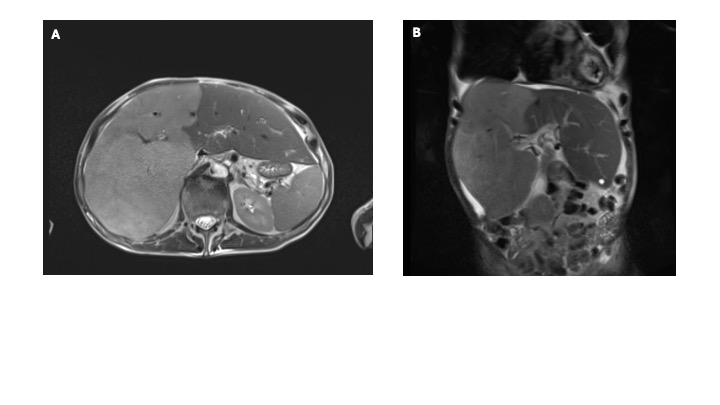Sunday Poster Session
Category: Liver
P1839 - An Unusual Disease With a Common Presentation: A Case of Metastatic Uveal Melanoma to the Liver
Sunday, October 26, 2025
3:30 PM - 7:00 PM PDT
Location: Exhibit Hall

Katherine Kedeshian, BS
Creighton University School of Medicine
Omaha, NE
Presenting Author(s)
Katherine Kedeshian, BS1, Thomas Rees. Checketts, DO2, Mason Klisares, DO3, Caitlin Foxley, MD, FHM4
1Creighton University School of Medicine, Omaha, NE; 2Creighton University, Omaha, NE; 3Creighton University Medical Center, Omaha, NE; 4Department of Veteran's Affairs, Omaha, Omaha, NE
Introduction: Uveal melanoma is a rare disease with an incidence of 0.0005% but is the most common primary malignancy of the eye in adults. Uveal melanoma metastasizes in around 50% of patients, with the liver being the first site of metastasis in 90% of cases, making regular surveillance critical. We report a case of metastatic uveal melanoma to the liver complicated by abdominal compartment syndrome.
Case Description/
Methods: A 66-year male with a past medical history of stage 1 uveal melanoma with enucleation 2018, alcohol use disorder and steatotic liver disease presented by private transport to the hospital with abdominal distension, fatigue, and early satiety over the preceding 6-8 weeks. The patient had been consuming 2-6 alcoholic beverages daily for 50 years.
Initial laboratory results showed elevated BUN, alkaline phosphatase, ALT, AST, creatinine and bilirubin. He had a firm and palpable abdominal mass extending beyond the right upper quadrant into the left and right lower abdomen. A lack of conjugate gaze in the right eye was noted secondary to prosthetic eye use. He underwent routine liver surveillance from 2018-2020 before being lost to follow-up. His 2020 MRI showed no metastasis to the liver and no hepatic cysts.
Imaging showed an ill-defined posterior right hepatic lobe mass. The attempt to do a paracentesis was unsuccessful due to very small ascites. Liver core biopsy indicated metastatic uveal melanoma after exhaustive staining. A radiation plan was discussed. Unfortunately, he developed abdominal compartment syndrome with acute renal failure and elected for home hospice where he passed two days later.
Discussion: Typically, patients with this social history and phenotype have alcohol-related cirrhosis with ascites. However, this patient had recurrent metastatic uveal melanoma, which has a very poor prognosis. When detected in the eye, surveillance is recommended at intervals of 4 to 6 months, based on the fast doubling time of untreated liver metastasis. Treatment is limited. A standard of care is only available for HLA-A *02:01 positive patients with metastases who can receive ipilimumab (monoclonal antibody). Response rates vary from 5% to 10%. This case highlights the importance of a thorough physical exam, history taking, and the avoidance of type II errors. Finally, ensuring that regular surveillance take place in patients with uveal melanoma.

Figure: Figure 1 – MRI without contrast
A. Posterior right hepatic lobe mass mostly tumor and/or necrosis (axial).
B. Posterior right hepatic lobe mass mostly tumor and/or necrosis (coronal).
Disclosures:
Katherine Kedeshian indicated no relevant financial relationships.
Thomas Checketts indicated no relevant financial relationships.
Mason Klisares indicated no relevant financial relationships.
Caitlin Foxley indicated no relevant financial relationships.
Katherine Kedeshian, BS1, Thomas Rees. Checketts, DO2, Mason Klisares, DO3, Caitlin Foxley, MD, FHM4. P1839 - An Unusual Disease With a Common Presentation: A Case of Metastatic Uveal Melanoma to the Liver, ACG 2025 Annual Scientific Meeting Abstracts. Phoenix, AZ: American College of Gastroenterology.
1Creighton University School of Medicine, Omaha, NE; 2Creighton University, Omaha, NE; 3Creighton University Medical Center, Omaha, NE; 4Department of Veteran's Affairs, Omaha, Omaha, NE
Introduction: Uveal melanoma is a rare disease with an incidence of 0.0005% but is the most common primary malignancy of the eye in adults. Uveal melanoma metastasizes in around 50% of patients, with the liver being the first site of metastasis in 90% of cases, making regular surveillance critical. We report a case of metastatic uveal melanoma to the liver complicated by abdominal compartment syndrome.
Case Description/
Methods: A 66-year male with a past medical history of stage 1 uveal melanoma with enucleation 2018, alcohol use disorder and steatotic liver disease presented by private transport to the hospital with abdominal distension, fatigue, and early satiety over the preceding 6-8 weeks. The patient had been consuming 2-6 alcoholic beverages daily for 50 years.
Initial laboratory results showed elevated BUN, alkaline phosphatase, ALT, AST, creatinine and bilirubin. He had a firm and palpable abdominal mass extending beyond the right upper quadrant into the left and right lower abdomen. A lack of conjugate gaze in the right eye was noted secondary to prosthetic eye use. He underwent routine liver surveillance from 2018-2020 before being lost to follow-up. His 2020 MRI showed no metastasis to the liver and no hepatic cysts.
Imaging showed an ill-defined posterior right hepatic lobe mass. The attempt to do a paracentesis was unsuccessful due to very small ascites. Liver core biopsy indicated metastatic uveal melanoma after exhaustive staining. A radiation plan was discussed. Unfortunately, he developed abdominal compartment syndrome with acute renal failure and elected for home hospice where he passed two days later.
Discussion: Typically, patients with this social history and phenotype have alcohol-related cirrhosis with ascites. However, this patient had recurrent metastatic uveal melanoma, which has a very poor prognosis. When detected in the eye, surveillance is recommended at intervals of 4 to 6 months, based on the fast doubling time of untreated liver metastasis. Treatment is limited. A standard of care is only available for HLA-A *02:01 positive patients with metastases who can receive ipilimumab (monoclonal antibody). Response rates vary from 5% to 10%. This case highlights the importance of a thorough physical exam, history taking, and the avoidance of type II errors. Finally, ensuring that regular surveillance take place in patients with uveal melanoma.

Figure: Figure 1 – MRI without contrast
A. Posterior right hepatic lobe mass mostly tumor and/or necrosis (axial).
B. Posterior right hepatic lobe mass mostly tumor and/or necrosis (coronal).
Disclosures:
Katherine Kedeshian indicated no relevant financial relationships.
Thomas Checketts indicated no relevant financial relationships.
Mason Klisares indicated no relevant financial relationships.
Caitlin Foxley indicated no relevant financial relationships.
Katherine Kedeshian, BS1, Thomas Rees. Checketts, DO2, Mason Klisares, DO3, Caitlin Foxley, MD, FHM4. P1839 - An Unusual Disease With a Common Presentation: A Case of Metastatic Uveal Melanoma to the Liver, ACG 2025 Annual Scientific Meeting Abstracts. Phoenix, AZ: American College of Gastroenterology.
